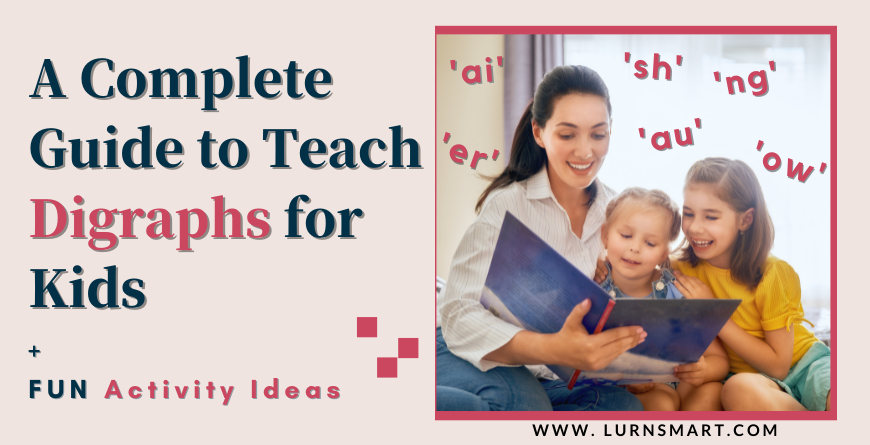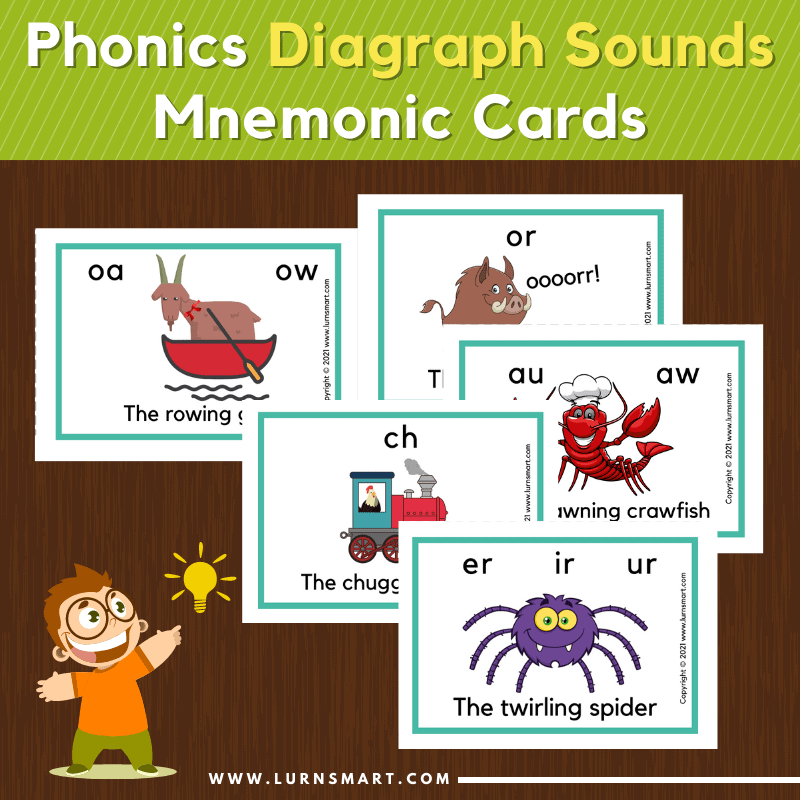A Complete Guide to Teach Digraph Sounds to Kids + Fun Activity Ideas
- Categories Early Learning, Reading
- Tags Reading time 4 min

‘What are digraph sounds?’
‘How can I teach digraph sounds to my child?’
‘My child struggles to notice digraphs in words, what should I do?’
If you are new to phonics teaching, the whole thing can be overwhelming and confusing!
Don’t worry!
In this post, I’ll help you learn all about an important phonics buzzword-digraphs and also share some interesting tips, strategies, and activity ideas to teach this important concept to your child.
So keep reading!
By the way, if you’re in a hurry, you can click on the link that is more relevant to you to get to a particular section of the blog post:
- What are digraph sounds?
- Difference between Digraphs and Blends + FREE Digraphs & Blends Chart
- How to introduce digraph sounds to kids?
- Fun activity ideas to teach digraph sounds to kids + FREE Activity Printables
- Overcoming challenges while introducing digraphs to kids
What are digraph sounds?
I assume that you are familiar with the 26 letter sounds A-Z, which are single letters representing a sound.
Letter Sound = ONE LETTER representing ONE SOUND
Here is an example,
The letter M makes the /m/ sound.
Note: If you want to learn fun ways to teach the 26 letter sounds in English to your child then check out my blog post 5 Interesting Activities to Teach the Letter Sounds + FREE Printables
Anyway, unlike single letter sounds, digraphs are two letters that join together to make a new sound.
Digraphs = TWO LETTERS representing ONE SOUND
Here are is an example,
Difference between Digraphs and Blends:
Oftentimes, people confuse digraphs with blends however digraphs and blends are not the same.
Digraphs: When two letters are put together, they make ONE sound.
Example: ‘ch’ in chick.
Blends: When two letters are put together, you hear BOTH sounds.
Example: ‘bl’ and ‘nd’ in blend.

Learning to differentiate digraphs from blends is essential.
So right from the very beginning encourage your child to pay close attention to the sounds in the word.
If you are looking for digraphs and blends list, then check out our FREE Digraphs Cards and FREE Consonant Blends Cards.
How to Introduce Digraph Sounds to Kids?
There are 18 digraphs and alternatives that you need to teach your child.
Although there is no one particular order to introduce digraphs, introducing them in logical and sequential order will help your child understand and remember them easily.
In our LURN Phonics-Reading Program for Kids, we introduce digraphs and their alternative spellings in the below order:
- Long Vowel Sounds – Two vowel letters or a vowel and the letters ‘y’/’w’ join together to make a new sound. Example: /ai/ as in sail.
- Consonant Digraphs – Two consonant letters pair up to make a new sound. Example: /sh/ as in ship.
- R-Controlled Sounds – When an R appears next to a vowel, it controls the vowel and makes it say a new sound. Example: /ar/ as in car.
- Vowel Digraphs – Two vowels or a vowel and the letters ‘y’/‘w’ pair up to make a new sound. Example: /aw/ as in jaw.
Fun Activity Ideas to Teach Digraph Sounds:
There are many ways to teach digraphs to kids, here are my top 5 picks:
1. DIGRAPH MNEMONIC FLASHCARDS:
Mnemonics is a memory device that helps learners learn and recall information easily.
You can either come up with your own pictures to help your child learn the digraph sounds and their spellings or use our Digraph Mnemonic cards.
Apart from using these cards to aid your child to link the digraph sounds and their spellings, you can play a fun game of ‘See and Act.’
To play this game, just show a card and let your child say the sound, and do the action.
This will help your child practice identifying and recognizing digraphs as quickly as possible.
2. DIGRAPH CLIP CARDS:
Digraph clip cards require the child to look at the picture, identify the digraph and choose from the options.
You can download our FREE Digraph Clip Cards to help your child practice identifying digraph sounds in words.
3. DIGRAPH ANCHOR CHARTS:
Digraph Anchor Charts are great for reviewing what was learned!
You can either use a binder ring to hold the charts together or stick them up in your child’s room for a quick reference.
4. DIGRAPH PICTURE SORTING:
Sorting picture cards according to their sounds is a wonderful game as it requires your child to identify and sort cards by paying close attention to the sounds in the word.
Check out our Digraph picture sorting cards for fun hands-on learning!
5. I SPY SHEETS:
I spy sheets are really interesting as they require your child to scan through the pictures and color the ones that are relevant.
Check out our I Spy Digraph Sheets to supplement your child’s understanding of digraphs and also practice differentiating between digraphs and blends.
6. DIGRAPHS SNAKES & LADDERS:
Snakes and ladders is a fun game that you can play with your child on a Saturday afternoon!
Download our FREE Digraph Snakes and Ladder Mat and have a great time helping your child practice recognizing digraphs!
By the way, if you are a parent who is looking for worksheets and other learning resources to teach digraphs and their alternative spellings, check out our Phonics Digraph Sounds & Alternatives Digital Bundle for Kids.
This bundle includes:
- Mnemonic flashcards to help kids learn and recall digraph sounds and their spellings easily.
- Practice words, sentences, and stories for each digraph sound for kids to practice reading.
- 50+ worksheets for hands-on learning that include more than 20 different activities such as cutting, gluing, sorting, coloring, tracing, crossword puzzles, mazes, and more to learn and practice:
- Long Vowel Sounds and their spellings
- Consonant Digraphs and their spellings
- R-Controlled Sounds and their spellings
- Vowel Digraphs and their spellings
- BONUS: 15 I Spy Digraph pages.
Overcoming Challenges While Teaching Digraph Sounds to Kids:
When you first introduce digraphs to your child, you are most likely to face the below challenges:
- Challenge #1: Child does not look at digraphs as a whole
- Challenge #2: A digraph sound represented by many spellings(less frequent spellings).
When you come across these challenges, here are some things that you can do to overcome them.
Challenge #1: Child does not look at digraphs as a whole
If your child does not look at digraphs as a whole, it is completely normal!
Remember that up until this point, your child had been sounding out each letter in the word and so it is normal for your child to continue to do the same— sound out each individual letter in the digraph like /s/ /h/ /i/ /p/ instead of /sh/ /i/ /p/.
If your child does this, don’t fret!
Remember, like all new things, looking at TWO letters as ONE takes time and practice.
So here is something that you can do!
Use your fingers to close the rest of the letters in the word and encourage your child to look at the digraphs as a whole.
Trust me, the more opportunity you give your child to notice digraphs in words, the sooner your child will learn to identify digraphs!

Challenge #2: A digraph sound represented by many spellings (less frequent spellings)
When you introduce digraph sounds to your child, you will for sure come across a sound that is represented by a less frequent spelling.
This might be confusing to you and your child.
Let me give you an example of what a less frequent spelling is, so you can understand the situation better!
For instance,
In English, the Long A sound can be represented by 9 different spellings—
- ‘ai’ as in ‘sail
- ‘ay’ as in hay
- ‘a_e’ as in ape
- ‘a’ as in acorn
- ‘ea’ as in break
- ‘ey’ as in key
- ‘eigh’ as in eight
- ‘ei’ as in vein
- ‘ae’ as in aerial
Teaching all the 9 spellings for the Long A sound is impractical and can only lead to confusion and frustration.
In phonics teaching, children are taught only the three most frequently appearing spellings for the Long A sound—‘ai’, ‘ay’, and ‘a_e’.
This is because the 3 frequent spellings alone can help a child decode most of the words with the Long A sound.
So once a child masters the 3 frequent spellings and can identify them in words, the child can then learn words that are made up of less frequent spellings as sight words.
I hope you found the tips and resources shared in this post useful.
If you did, don’t forget to share this blog post with your friends, and don’t forget to leave me a comment below!
Would love to hear from you!
Final Notes:
If you are supporting your child to read at home, then you might want to read my blog post Teach Your Child to Read Using Phonics: The Ultimate 7-Step Guide for step-by-step instructions and all the necessary resources that you might need to help your child read and spell easily!
If you are looking for a kid’s reading program, I welcome you to join our LURN Phonics Kid’s Reading Program which is a step-by-step parent-led program that is designed to help your child read and spell fluently and efficiently!
To take up this program, you do not need any prior phonics knowledge or teaching experience!
Everything is so simplified for you that all you need is a playful attitude and the enthusiasm to set aside 10-15 minutes a day to teach your child to read!
The best part is, our reading program is multisensorial and fun-based so no more tears while learning to read but lots of fun and play!
So go ahead and check out our LURN Phonics Kid’s Reading Program and I cannot wait to help you help your little one become an amazing reader and speller 🙂
You may also like











